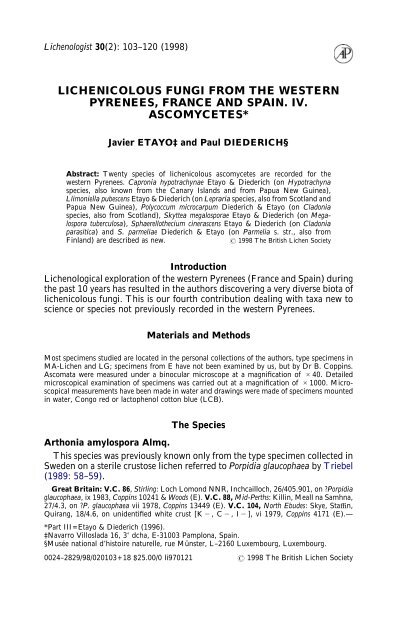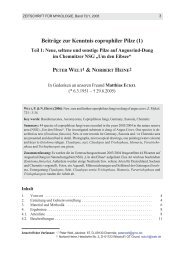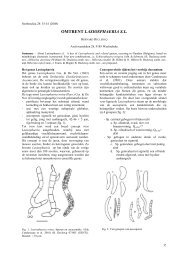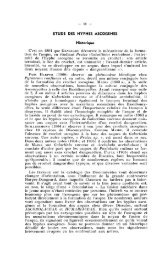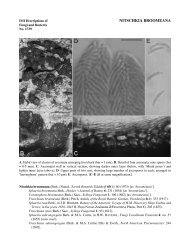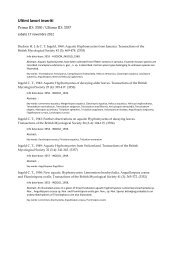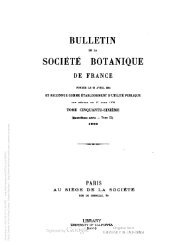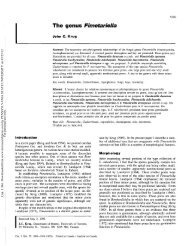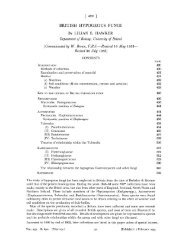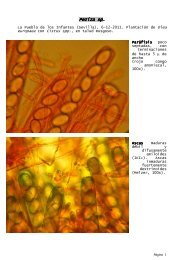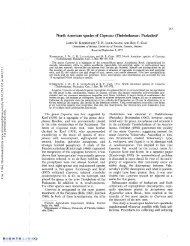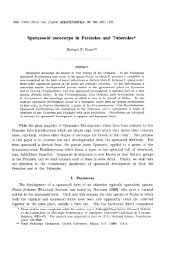LICHENICOLOUS FUNGI FROM THE WESTERN PYRENEES, FRANCE AND SPAIN ...
LICHENICOLOUS FUNGI FROM THE WESTERN PYRENEES, FRANCE AND SPAIN ...
LICHENICOLOUS FUNGI FROM THE WESTERN PYRENEES, FRANCE AND SPAIN ...
You also want an ePaper? Increase the reach of your titles
YUMPU automatically turns print PDFs into web optimized ePapers that Google loves.
Lichenologist 30(2): 103–120 (1998)<br />
<strong>LICHENICOLOUS</strong> <strong>FUNGI</strong> <strong>FROM</strong> <strong>THE</strong> <strong>WESTERN</strong><br />
<strong>PYRENEES</strong>, <strong>FRANCE</strong> <strong>AND</strong> <strong>SPAIN</strong>. IV.<br />
ASCOMYCETES*<br />
Javier ETAYO‡ and Paul DIEDERICH§<br />
Abstract: Twenty species of lichenicolous ascomycetes are recorded for the<br />
western Pyrenees. Capronia hypotrachynae Etayo & Diederich (on Hypotrachyna<br />
species, also known from the Canary Islands and from Papua New Guinea),<br />
Llimoniella pubescens Etayo & Diederich (on Lepraria species, also from Scotland and<br />
Papua New Guinea), Polycoccum microcarpum Diederich & Etayo (on Cladonia<br />
species, also from Scotland), Skyttea megalosporae Etayo & Diederich (on Megalospora<br />
tuberculosa), Sphaerellothecium cinerascens Etayo & Diederich (on Cladonia<br />
parasitica) and S. parmeliae Diederich & Etayo (on Parmelia s. str., also from<br />
Finland) are described as new. 1998 The British Lichen Society<br />
Introduction<br />
Lichenological exploration of the western Pyrenees (France and Spain) during<br />
the past 10 years has resulted in the authors discovering a very diverse biota of<br />
lichenicolous fungi. This is our fourth contribution dealing with taxa new to<br />
science or species not previously recorded in the western Pyrenees.<br />
Materials and Methods<br />
Most specimens studied are located in the personal collections of the authors, type specimens in<br />
MA-Lichen and LG; specimens from E have not been examined by us, but by Dr B. Coppins.<br />
Ascomata were measured under a binocular microscope at a magnification of 40. Detailed<br />
microscopical examination of specimens was carried out at a magnification of 1000. Microscopical<br />
measurements have been made in water and drawings were made of specimens mounted<br />
in water, Congo red or lactophenol cotton blue (LCB).<br />
The Species<br />
Arthonia amylospora Almq.<br />
This species was previously known only from the type specimen collected in<br />
Sweden on a sterile crustose lichen referred to Porpidia glaucophaea by Triebel<br />
(1989: 58–59).<br />
Great Britain: V.C. 86, Stirling: Loch Lomond NNR, Inchcailloch, 26/405.901, on ?Porpidia<br />
glaucophaea, ix 1983, Coppins 10241 & Woods (E). V.C. 88, Mid-Perths: Killin, Meall na Samhna,<br />
27/4.3, on ?P. glaucophaea vii 1978, Coppins 13449 (E). V.C. 104, North Ebudes: Skye, Staffin,<br />
Quirang, 18/4.6, on unidentified white crust [K, C,I], vi 1979, Coppins 4171 (E).—<br />
*Part III=Etayo & Diederich (1996).<br />
‡Navarro Villoslada 16, 3 dcha, E-31003 Pamplona, Spain.<br />
§Musée national d’histoire naturelle, rue Münster, L–2160 Luxembourg, Luxembourg.<br />
0024–2829/98/020103+18 r25.00/0 li970121 1998 The British Lichen Society
104 <strong>THE</strong> LICHENOLOGIST Vol. 30<br />
Spain: Navarra: P to de Larrau, 1585 m, calcareous schists, on an unidentified crust [medulla<br />
I+blue] (Porpidia?), vii 1993, Etayo 11889.<br />
Arthonia graphidicola Coppins<br />
This species is known from England, Scotland and Ireland (Coppins 1992:<br />
82), France (Coste 1993) and Luxembourg (Diederich et al. 1991: 9). Our<br />
specimen agrees well with the description given by Coppins (1989), except<br />
that the brown hyphae in the host thallus are I+blue.<br />
Spain: Navarra: Leazcue, 580 m, on Graphis scripta (with Stigmidium microspilum), iii 1996,<br />
Etayo 13830.<br />
Arthonia thelotrematis Coppins<br />
This species is confined to Thelotrema lepadinum growing on Corylus. Itis<br />
already known from the British Isles and the Azores (Coppins 1992: 87), and<br />
is thus new for continental Europe.<br />
France: Pyrénées-Atlantiques: S te -Engrâce, Gorges de Kakouetta, on Corylus, onThelotrema<br />
lepadinum, vii 1993, Etayo 12087.<br />
Arthrorhaphis aeruginosa R. Sant. & Tønsb.<br />
Recently described by Santesson & Tønsberg (1994) from Norway,<br />
Scotland and North America. These are the first records from the Pyrenees,<br />
where the species grows at a high altitude in the subalpine belt, and from<br />
England.<br />
France: Pyrénées-Atlantiques: Col de Suscousse, near the sky station, on road to Arette, c.<br />
1200 m, vi 1992, Etayo 12091 & Printzen (hb. Etayo).—Great Britain: V.C. 5, South Somerset:<br />
Exmoor, Barle Valley, Hawkridge Wood, 21/88.29, v 1994, Coppins 16187 & O’Dare (E). V.C.<br />
104, North Ebudes: Skye: S of Kyle of Lochalsh, S of Loch Na Béiste, v 1987, Diederich 8858; SSE<br />
of Broadford, Ardnameacan, v 1987, Diederich 8305; W of Torrin, Allt na Dunaiche, v 1987,<br />
Diederich 8182. (All on Cladonia squamules.)<br />
Capronia hypotrachynae Etayo & Diederich sp. nov.<br />
Capronia lichenicola a C. epilobarina ascomatibus latioribus et setis brevioribus, et a C.<br />
normandinae et C. pseudonormandinae ascosporis transverse 3–5-septatis, ascis brevioribus et<br />
ascomatibus latioribus differt.<br />
Typus: Spain, Navarra, Valle del Baztán, Legate, peñas del Aracán, 871 m, on Fagus, on<br />
Hypotrachyna revoluta, vii 1993, Etayo 13861 & Breuss (MA-Lichen—holotypus; hb. Diederich,<br />
hb. Etayo—isotypi).<br />
(Fig. 1)<br />
Ascomata perithecioid, ostiolate, 130–200 m diam., globose, black, dispersed,<br />
initially immersed, breaking through the cortex of the host thallus and<br />
partly covered by it later; setae dark brown, aseptate, simple, thick-walled,<br />
5–353–4 m, in many ascomata all under 10 m long and almost invisible<br />
macroscopically; perithecial wall c. 15–20 m thick, of textura angularis, dark<br />
brown in the outer part, hyaline in the inner part, with cells 5–82–4 m.
1998 Pyrenees lichenicolous ascomycetes—Etayo & Diederich 105<br />
A 1<br />
A 2<br />
C 2<br />
Fig. 1. Capronia hypotrachynae: A, Habitus (A1, holotype; A2, Diederich 10137b); B, Ascus<br />
apex in water (holotype); C, Ascospores (C1, in water, Etayo 13859; C2, in LCB, Diederich<br />
10137b; C3, in water, holotype). Scales: A=100 m, B–C=10 m.<br />
Hamathecium absent at maturity; centrum I. Asci clavate, bitunicate, wall<br />
apically thickened, epiplasma I+ orange, 8-spored, 50–6810–16 m, with<br />
ascospores irregularly arranged in the ascus. Ascospores 0–3-septate<br />
when young, submuriform when mature, with 3–5 transverse and 0–1<br />
longitudinal septa, constricted at the septa, not halonate, light grey to<br />
brownish, 12–195·5–7·5 m.<br />
Hosts: Hypotrachyna costaricensis (Nyl.) Hale, H. endochlora (Leight.) Hale<br />
and H. revoluta (Flörke) Hale (thallus).<br />
Distribution: The new species is known from France, continental Spain, the<br />
Canary Islands (Gomera) and Papua New Guinea.<br />
C 1<br />
C 3<br />
B
106 <strong>THE</strong> LICHENOLOGIST Vol. 30<br />
Notes: In the specimen from Papua New Guinea, most ascomata are densely<br />
covered by long setae that are up to 35 m long. Some ascomata in the same<br />
collection appear to be glabrous under the stereomicroscope, and only short<br />
setae, reaching 10 m in length, are visible using a microscope (magnification1000).<br />
In the European specimens, no ascomatal setae could be<br />
seen macroscopically, which led us to believe initially that a different species<br />
was involved; microscopically, however, numerous short setae can also be<br />
observed in these European specimens, which are indistinguishable otherwise<br />
from the material from Papua New Guinea. The new species could<br />
be confused with several other lichenicolous species of Capronia with submuriform<br />
ascospores: Capronia epilobarina Kondratyuk & D. J. Galloway (see<br />
Etayo & Diederich 1996: 96), C. normandinae (see below) and C. pseudonormandinae<br />
Diederich (Aptroot et al. 1997: 47–48). The distinguishing features<br />
of these species are summarized in Table 1.<br />
Additional specimens examined: France: Pyrénées-Atlantiques: Col de Burdincurutcheta, 800 m, in<br />
a Fagus-Abies wood, on Hypotrachyna revoluta, iv 1995, Etayo 13860.—Spain: Navarra: Urroz de<br />
Santesteban, pantano de Leurtza, 900 m, on Fagus, onH. revoluta, ii 1994, Etayo 13859. Canary<br />
Islands: Gomera, Vallehermoso, raso de la Bruma, 1000 m, on H. endochlora, viii 1994, Etayo<br />
13177.—Papua New Guinea: Simbu prov.: Mount Wilhelm, Pindaunde valley, near the hut on<br />
the shore of lake Piunde, 3600 m, terricolous, on H. costaricensis, viii 1992, Diederich 10137 (b).<br />
Capronia normandinae R. Sant. & D. Hawksw.<br />
This species, confined to Normandina pulchella, is already known from<br />
Chile, Madeira and Scotland (Hawksworth 1990: 395–397) and from Papua<br />
New Guinea (Aptroot et al. 1997: 47), and is therefore new to continental<br />
Europe.<br />
France: Pyrénées-Atlantiques: S of Tardets-Sorholus, Gorges de Kakouetta, on N. pulchella, vii<br />
1991, Diederich 9560, 9581.—Spain: Navarra: Roncesvalles, Lindux, on Fagus, onN. pulchella<br />
(with Sclerococcum normandinae), ix 1991, Etayo 6017.<br />
Dacampia rufescentis (Vouaux) D. Hawksw.<br />
Hawksworth (1986: 497–500) reported this species on Peltigera rufescens<br />
from northern France and Great Britain.<br />
Spain: Navarra: W Pamplona, Sierra de Urbasa, P to de Urbasa, on Peltigera sp., vii 1991,<br />
Diederich 9646; Baraibar, S of Miguel de Aralar, track to Casa forestal, on P. rufescens, vii 1993,<br />
Etayo 11959 & Breuss.<br />
Guignardia olivieri (Vouaux) Sacc.<br />
This species is known from many European countries, and from Israel,<br />
mostly on Xanthoria parietina (Clauzade et al. 1989: 47; Etayo 1996;<br />
Kondratyuk et al. 1996: 60–61; Navarro-Rosinés et al. 1994; Santesson 1993:<br />
87).<br />
Spain (all on Xanthoria parietina): Navarra: W of Pamplona, Sierra de Urbasa, P to de Urbasa,<br />
vii 1991, Diederich 9631 & Etayo 5946; Cilveti, on Acer, xii 1994, Etayo 12251; alto de Erro,<br />
800 m, iv 1995, Etayo 12877; Iragui, 700 m, Quercus faginea wood, iii 1996, Etayo 13808. Soria:
1998 Pyrenees lichenicolous ascomycetes—Etayo & Diederich 107<br />
Table 1. The features distinguishing the known lichenicolous Capronia species with submuriform ascospores*<br />
Species<br />
C. hypotrachynae C. epilobarina C. normandinae C. pseudonormandinae<br />
Ascomatal diam. 130–200 50–70 100–150 100–150<br />
Setal length 5–35 35–70 25–50(–90) 10–30<br />
Asci 50–6810–16 45–5014–17 65–8022–30 70–8012·5–15<br />
Ascospore septa 3–50–1 3–50–1 (3–)5(–6)0–1(–2) 30–1<br />
Ascospore size 12–195·5–7·5 17–233·5–7 15–217·5–9 12·5–166–7·5<br />
Host Hypotrachyna species Lobraria species Normandina pulchella Host of Lauderlindsaya simodense<br />
*All measurements are given in m.
108 <strong>THE</strong> LICHENOLOGIST Vol. 30<br />
A<br />
Calatañazor, road to La Fuentona, 1000 m, viii 1995, Etayo 12988. La Rioja: Tierra de Cameros,<br />
Gallinero de Cameros, 1000 m, iv 1996, Etayo s.n.<br />
Llimoniella pubescens Etayo & Diederich sp. nov.<br />
Llimoniella lichenicola, a L. neglecta excipulo pubescenti et ascosporis brevioribus interdum<br />
1-septatis differt.<br />
Typus: Spain, Navarra, alto de Lizarraga, 900 m, on Fagus, onLepraria lobificans, iv 1992,<br />
Etayo 3052 (MA-Lichen—holotypus; LG, hb. Diederich, hb. Etayo—isotypi).<br />
(Fig. 2)<br />
B<br />
C<br />
Fig.2. Llimoniella pubescens (holotype): A, Habitus; B, Ascospores; C, Excipular hairs (schematically<br />
below); D, Exciple; E, Asci and paraphyses. Scales: A=100 m, B–E=10 m.<br />
D<br />
E
1998 Pyrenees lichenicolous ascomycetes—Etayo & Diederich 109<br />
Ascomata apothecia, lichenicolous on the thallus of Lepraria, at first<br />
immersed, later erumpent, 0·09–0·25 mm diam., black, initially closed,<br />
opening by a pore, covered by black hairs, attached to the substratum by a<br />
narrow foot. Ectal exciple greenish grey, K+ blackish brown, 20–25 m thick<br />
in the lower part, 10 m thick laterally, prosoplectenchymatous, not carbonized;<br />
hairs greenish grey, wall thin and uniform, smooth, non-septate,<br />
15–303–4 m (2m thick near the apex). Hymenium olivaceous green,<br />
more strongly pigmented in the upper and in the lower parts, 40–45 m tall.<br />
Paraphyses filiform, 1·5–2 m thick. Asci cylindrical, 35–525·5–6·5 m,<br />
wall uniformly thin, not reacting with iodine, 8-spored. Ascospores hyaline,<br />
ellipsoid, 0–1-septate, 5·5–92·5–3·2 m.<br />
Hosts: Lepraria species, including L. lobificans Nyl. The host of the type<br />
specimen has been studied by TLC and contains atranorin, zeorin, stictic and<br />
constictic acids. The other specimens were too small for TLC analysis.<br />
Distribution: Known from the Spanish Pyrenees, Scotland and Papua New<br />
Guinea.<br />
Notes: The new species is similar to L. neglecta (Vain.) Triebel & Rambold,<br />
from which it is distinguished by the presence of excipular hairs, and by shorter<br />
ascospores that become 1-septate [the ascospores measure 9–11(–14)2–<br />
3(3·5) m in L. neglecta]. It may be conspecific with a specimen with<br />
excipular hairs mentioned by Kümmerling et al. (1993) on Lepraria sp., and<br />
illustrated by those authors (loc. cit.: 155, fig. 2). Llimoniella neglecta seems to<br />
be confined to species of the Lepraria neglecta-group (Kümmerling et al. 1993).<br />
The new species is known from L. lobificans and possibly another unidentified<br />
species from New Guinea, both not belonging to the L. neglecta-group.<br />
Additional specimens examined: Great Britain: V.C. 104, North Ebudes: Skye: SW Broadford,<br />
S of grave yard, on Lepraria lobificans, v 1987, Diederich 8176; Tokavaig wood, on Lepraria sp., v<br />
1987, Diederich 8098.—Spain: Navarra: Lecumberri, S of Miguel de Aralar, Artzainzulo cave,<br />
758 m, on calcareous rock in a cave, on Lepraria sp., xi 1991, Etayo 11296 & Calvo.—Papua New<br />
Guinea: Madang prov.: Finisterre range, Yupna valley, Teptep village, trail in NNW and deep<br />
valley in N direction, 2500 m, 557S, 14633E, on Lepraria sp., vii 1992, Diederich 10730.<br />
Muellerella hospitans Stizenb.<br />
Our collections seem to represent the first Iberian records of this species<br />
growing in apothecia of Bacidia fraxinea and B. rubella.<br />
Spain: Navarra: La Barranca, Urdiain, 525 m, on Bacidia rubella, ii 1988, Etayo 4041; Sierra<br />
de Urbasa, Cargadero, 920 m, on B. fraxinea, iii 1991, Etayo 5816; ibid., Crezmendi, 1100 m,<br />
Etayo 469; Leazcue, 580 m, Fagus wood, on B. rubella, iii 1996, Etayo 13789.<br />
Opegrapha anomea Nyl.<br />
Opegrapha pertusariae<br />
(Vouaux) Hafellner<br />
(Fig. 3)
110 <strong>THE</strong> LICHENOLOGIST Vol. 30<br />
A<br />
B<br />
Fig. 3.Opegrapha anomea (Etayo 12678 & Printzen). A, Immature asci and paraphyses (left),<br />
mature asci with hyaline ascospores (right); B, Mature ascospores. Scales: A–B=10 m.<br />
Two closely related Opegrapha species with elongate ascomata and 3septate<br />
ascospores have been described on Pertusaria: O. anomea has hyaline<br />
ascospores, 23–267–9 m, and is known from France on P. amara;<br />
O. pertusariae, with ascospores hyaline when young, brown at maturity and<br />
20–268–9 m, is known from the Canary Islands on P. exalbescens<br />
(Clauzade et al. 1989: 63; Hafellner 1994: 16). As the colour of the ascospores<br />
may depend only on the degree of maturity, we propose to consider both taxa<br />
provisionally as synonymous. The ascospores in our specimens are 3-septate,<br />
hyaline when young, brown at maturity and 22–267–8·5 m.<br />
France: Pyrénées-Atlantiques: Col de Suscousse near ski station, on Fagus, on Pertusaria<br />
albescens, vi 1992, Etayo 12678 & Printzen (hb. Etayo); SW of Larrau, near the road to Spain, in<br />
a Fagus wood, on P. amara, vii 1990, Diederich 9179.
1998 Pyrenees lichenicolous ascomycetes—Etayo & Diederich 111<br />
Plectocarpon sampaianae Diederich & Etayo<br />
This cryptic species, restricted to Fuscopannaria sampaiana, was previously<br />
known from two collections in Spain and Scotland (Diederich & Etayo 1994).<br />
It is new for France.<br />
France: Pyrénées-Atlantiques: Bois d’Astaquieta, road to Occabe and Esterençuby, 1200 m, iv<br />
1995, Etayo 12895.—Great Britain: V.C. 97, Westerness: N side of Loch Sunart, 1 km SE of<br />
Salen, An Cnap, c. 17/695.641, iii 1983, Coppins 9323 & Jørgensen (E); 3 km E of Glenfinnan,<br />
Drochaid Sgainnir, 17/931.799, vi 1978, Coppins 3533 (E). V.C. 98, Argyll Main: Loch Creran,<br />
Glasdrum, 27/00.45, v 1976, Coppins 1829 & Tibell (E); Inverary, Glen Shira, SW of Kilblaan,<br />
27/126.130, i 1996, B. J. &A. M. Coppins 16764 (E); E of Inverary, Achnatra Woods, E of<br />
Achnatra, 27/13.09, i 1996, B. J. &A. M. Coppins 16773 (E).—Spain: Navarra: Lanz, 750 m,<br />
on Fagus, x 1994, Etayo 12591. (All specimens on Fuscopannaria sampaiana.)<br />
Polycoccum microcarpum Diederich & Etayo sp. nov<br />
Ascomata lichenicola, perparva, 30–60 m diam., subglobosa, ostiolata, atra, aggregata; paries<br />
brunnea, 6–9 m crassa, cellulis 2–4 m. Pseudoparaphyses anastomosantes, 1·5–2 m latae,<br />
centrum I. Asci elongato-clavati, bitunicati, 30–3515 m, 8-spori. Ascosporae 1-septatae,<br />
ovales, laeves, fuscae, 12–14·54·5–7 m.<br />
Typus: France, Pyrénées-Atlantiques, route de Arette vers Arette-la-Pierre-S t -Martin, sous le<br />
Pic Soulaing au Bois de Guillers, 1300 m, futaie de hêtres et de sapins, on Cladonia, vii 1989,<br />
Sérusiaux 10580 (a), James & Rose (LG—holotypus; hb. Diederich—isotypus).<br />
(Fig. 4)<br />
Ascomata perithecioid, immersed in convex galls on the squamules of the<br />
host, arising by groups of 20–80, black, ostiolate, 30–60(–100) m diam.; wall<br />
brown, 6–9 m thick, composed of polyhedral or elongate cells, 2–4 m thick,<br />
at maturity dark brown and much thicker around the ostiole. Hamathecium<br />
composed of anastomosing pseudoparaphyses, 1·5–2 m thick, I (in<br />
Lugol’s). Asci elongate-clavate, bitunicate, 30–3515 m, 8-spored, I.<br />
Ascospores brown, 1-septate, slightly constricted at the septum, cells often<br />
unequal in size, without a distinct ornamentation, 12–14·54·5–7 m.<br />
Hosts: Cladonia species, incl. C. bellidiflora (Ach.) Schaer., C. cervicornis<br />
(Ach.) Flot. subsp. cervicornis (squamules) and C. digitata (L.) Hoffm.<br />
Distribution: France (Pyrénées-Atlantiques) and Great Britain (Isle of Skye).<br />
Notes: Macroscopically, this species is easily recognized by the formation of<br />
gall-like swellings on the squamules of Cladonia, containing numerous<br />
extremely small ascomata. In the centre of the galls, the perithecia are often<br />
growing very close to each other and are sometimes connected by a blackish<br />
tissue. The new species is distinguished from all other species of the genus by<br />
the much smaller ascomata. Polycoccum cladoniae Diederich & D. Hawksw.,<br />
which is also known from Cladonia, has larger ascomata (100–250 m diam.),<br />
which are dispersed over the host thallus and superficial at maturity, longer<br />
asci and larger ascospores (Hawksworth & Diederich 1988).
112 <strong>THE</strong> LICHENOLOGIST Vol. 30<br />
B<br />
A<br />
Fig. 4.Polycoccum microcarpum (holotype): A, Galls on Cladonia sp.; B, Asci; C, Ascospores.<br />
Scales: A=1 mm, B–C=10 m.<br />
Additional specimens examined: France: Pyrénées-Atlantiques: S te -Engrâce, Ravin de Soudet,<br />
bois d’Arbouty, i 1993, on C. bellidiflora, Etayo 3451 (hb. Etayo, hb. Diederich); 4 km from<br />
station d’Issarbe, 1375 m, on Cladonia digitata, iv 1995, Etayo 12910.—Great Britain: V.C.<br />
104, North Ebudes: Skye, SW Broadford, S of grave yard, on C. cervicornis s. str., v 1987, Diederich<br />
8158.<br />
C
1998 Pyrenees lichenicolous ascomycetes—Etayo & Diederich 113<br />
Reconditella physconiarum Hafellner & Matzer<br />
This is the first Spanish record of this recently described species, previously<br />
known from Austria, Croatia, Portugal and Sweden (Matzer & Hafellner<br />
1990).<br />
Spain: Navarra: Iragui, 700 m, on Quercus faginea,onPhysconia distorta, iii 1996, Etayo 13788,<br />
13851.<br />
Roselliniopsis tartaricola (Nyl.) Matzer<br />
A common lichenicolous ascomycete, confined to Pertusaria hemisphaerica<br />
and Ochrolechia tartarea (Matzer 1993). Our specimen had been reported by<br />
Diederich & Roux (1991: 22) as R. tropica Matzer & R. Sant. The differences<br />
between both species are explained in Matzer (1993).<br />
France Pyrénées-Atlantiques: S of Tardets-Sorholus, between S te -Engrâce and Pierre-S t -Martin,<br />
in a forest with Fagus and Abies, onPertusaria hemisphaerica, vii 1990, Diederich 9371.<br />
Skyttea megalosporae Etayo & Diederich sp. nov.<br />
Ascomata lichenicola, in thallis Megalosporae crescentia, immersa, primo clausa, poro aperientia;<br />
excipulum viride, pilis viridulis, 8–112·5–3 m; hypothecium hyalinum; epihymenium viridulum;<br />
paraphyses filiformes, simplices. Asci 45–555–6 m, apice incrassati, I, 8-spori.<br />
Ascosporae hyalinae, falcatae ad sigmoideae, extremitatibus acutis, 0(–1)-septatis, 22–462·5–<br />
3 m.<br />
Typus: France, Pyrénées-Atlantiques, au sud de Tardets-Sorholus, S te -Engrâce, vers Pierre-<br />
S t -Martin, à 3 km après la dernière maison, col de Suscousse, Fagus-Abies wood, on Megalospora<br />
tuberculosa, vii 1991, Etayo 5904 & Diederich (MA-Lichen—holotypus; hb. Diederich, hb.<br />
Etayo—isotypi); ibid., vii 1990, Diederich 9360 (hb. Diederich—topotypus).<br />
(Fig. 5)<br />
Ascomata immersed or rarely erumpent, margin often covered by the host<br />
thallus, black, 70–120 m diam., initially closed, opening by a pore. Lateral<br />
exciple green, c. 40m thick; basal exciple greenish brown, c. 15m thick,<br />
prosoplectenchymatous; excipular hairs greenish, slightly curved, 8–112·5–<br />
3 m; hypothecium hyaline, c. 10m thick; epihymenium greenish; hymenium<br />
of filiform, simple paraphyses, KI; all greenish parts are K. Asci<br />
cylindrical to clavate, 45–555–6 m, wall apically thicker, 8-spored.<br />
Ascospores hyaline, falcate to sigmoid, with acute ends, 0(–1) septate, 22–<br />
462·5–3 m.<br />
Host: Megalospora tuberculosa (Fée) Sipman (thallus), sometimes accompanied<br />
by Dactylospora microspora Etayo, D. cf. urceolata (Th. Fr.) Arnold<br />
or Sclerococcum hawksworthii Etayo & Diederich.<br />
Distribution: Common in the western French and Spanish Pyrenees.<br />
Notes: The new species is similar to S. fusispora Sherw., D. Hawksw. &<br />
Coppins, but the ascospores are longer (20–282·5–3·5 m inS. fusispora),<br />
more curved, sigmoid, and with acute apices (see Sherwood-Pike et al. 1980:
114 <strong>THE</strong> LICHENOLOGIST Vol. 30<br />
A<br />
484–486). According to the original description of S. fusispora, the apothecia<br />
in our new species are also smaller, and the exciple and excipular hairs more<br />
greenish.<br />
The curved, sigmoid ascospores are also reminiscent of Spirographa, another<br />
genus of the Odontotremataceae. The recently described Spirographa vinosa<br />
Holien & Triebel has ascospores that are similar to those of Skyttea megalosporae,<br />
except that they are up to 5-septate (Holien & Triebel 1996). As<br />
Spirographa vinosa differs from Skyttea megalospora in having superficial<br />
apothecia lacking excipular hairs, we believe that both species are not<br />
congeneric, and that the new species is better placed in the genus Skyttea.<br />
Additional specimens examined (all on Megalospora tuberculosa): France: Pyrénées-Atlantiques:<br />
Forêt d’Iraty, chalet Pedro, 1000 m, on Fagus, vii 1991, Etayo 5918 & Diederich; ibid., iv 1995,<br />
Etayo 12901; forêt de Sare, near Bera de Bidasoa, col de Lizuniaga, 150 m, iii 1994, Etayo 12955;<br />
ibid., iii 1995, Etayo 12740 & Marbach; bois d’Astaquieta, road to Occabe and Esterençuby,<br />
1200 m, Fagus wood, iv 1995, Etayo 12904; S te -Engrâce, ravin de Termy, on Fagus, vii 1993,<br />
Etayo 12956.—Spain: Navarra: Mendilaz, Mendilaz, 1200 m, Fagus wood, vii 1989, Etayo 5949;<br />
Oronoz-Mugaire, señorío de Bértiz, c. 400 m, Fagus wood, i 1994, Etayo 12087.<br />
Sphaerellothecium cinerascens Etayo & Diederich sp. nov.<br />
Ascomata lichenicola, perparva, 40–70 m diam., subglobosa, ostiolata, atra, semi-immersa vel<br />
superficialia. Hyphae 10–152–3 m, fuscae, debiliter evolutae. Hamathecium nullum. Asci<br />
B<br />
C D<br />
Fig. 5. Skyttea megalosporae (Etayo 12955): A, Habitus, on the thallus of Megalospora tuberculosa;<br />
B, Ascospores; C, Excipular hairs; D, Ascus apex. Scales: A=100 m. B–D=10 m.
1998 Pyrenees lichenicolous ascomycetes—Etayo & Diederich 115<br />
B<br />
clavati, crassitunicati, 8-spori, 31–408·5–11 m. Ascosporae 1-septatae, ovales, fuscae,<br />
9–11·53–4 m.<br />
Typus: Spain, Navarra, Oronoz-Mugaire, señorío de Bértiz, on the base of an old trunk of<br />
Castanea sativa, on Cladonia parasitica, xii 1985, Etayo 953 (MA-Lichen—holotypus; hb.<br />
Etayo—isotypus).<br />
(Fig. 6)<br />
D<br />
Fig. 6. Sphaerellothecium cinerascens (holotype): A, Habitus, on squamules of Cladonia parasitica;<br />
B, Asci; C, Ascospores; D, Germinating ascospores. Scales: A=200 m, B–D=10 m.<br />
A<br />
C
116 <strong>THE</strong> LICHENOLOGIST Vol. 30<br />
Ascomata perithecioid, 40–70 m diam., subglobose, ostiolate, black, dark<br />
brown when wet, first semi-immersed, later superficial, scattered or in groups.<br />
Vegetative hyphae 2–3 m thick, brown (orange brown in KOH), branchedanastomosed,<br />
not or slightly constricted at the septa, not forming a superficial<br />
net on the host thallus, irregularly immersed, visible at a high magnification.<br />
Ascomatal wall brown, paraplectenchymatous, formed by isodiametric cells,<br />
4–8 m diam.; ostiole not prominent. Hamathecium without any visible<br />
paraphysoids or periphysoids at maturity, I; periphyses developed in the<br />
upper part of the ascoma, simple, small, less than 101·5 m. Asci clavate,<br />
31–408·5–11 m, wall apically thickened, young asci with a large ocular<br />
chamber, ascoplasma I+ yellow to orange, 8-spored, with ascospores irregularly<br />
arranged. Ascospores 1-septate, rarely 3-septate when mature, oval to<br />
ellipsoid, slightly constricted at the septum, not halonate, brown (grey–brown<br />
in KOH), 9–11·53–4 m.<br />
Host: Cladonia parasitica (Hoffm.) Hoffm. The thallus of the host changes to<br />
a characteristic grey tinge when colonized by S. cinerascens.<br />
Distribution: Known from oceanic woods of the western Pyrenees in Spain<br />
and France.<br />
Notes: We include this species provisionally in the genus Sphaerellothecium<br />
because of the I reaction of the hamathecium and the asci, the brown<br />
ascospores and hyphae, and the absence of setae on the ascomatal wall.<br />
Hamathecial filaments have not been found with certainty and should be<br />
looked for carefully on richer material.<br />
Two similar fungi have been described on species of Cladonia: Echinothecium<br />
cladoniae Keissl., a name of uncertain application and not validly published,<br />
refers to a lichenicolous fungus with setose perithecia (Santesson 1993: 79).<br />
Sphaerellothecium cladoniicola E. S. Hansen & Alstrup differs by a distinct<br />
superficial net of vegetative hyphae, hyaline ascospores and shorter asci<br />
(Hansen & Alstrup 1995: 35–37).<br />
Most other species of Sphaerellothecium described by Hafellner (1993:<br />
760–762), Triebel (1989) and Triebel et al. (1991) differ either in the<br />
presence of a distinct superficial net of dark hyphae or by hyaline ascospores,<br />
which become brownish only when post-mature. Sphaerellothecium coniodes<br />
(Nyl.) Cl. Roux & Diederich and S. propinquellum (Nyl.) Cl. Roux & Triebel<br />
both have larger ascospores (Roux & Triebel 1994: 527–533). In S. atryneae<br />
(Arnold) Cl. Roux & Triebel, the ascospores remain hyaline or pale for a long<br />
time and are slightly larger, the asci are broader, and the vegetative hyphae are<br />
thicker (Roux & Triebel 1994: 525–527).<br />
The epithet cinerascens refers to the green thallus of the host turning greyish<br />
in the presence of the parasite.<br />
Additional specimens examined (both on Cladonia parasitica): France: Pyrénées-Atlantiques:<br />
Ibarre, near S t -Jean-Pied-De-Port, vi 1992, Etayo 3452 & Printzen (hb. Etayo, hb. Diederich).—<br />
Spain: Navarra: Ituren, monte Mendaur, xii 1986, Etayo 2040.
1998 Pyrenees lichenicolous ascomycetes—Etayo & Diederich 117<br />
B<br />
A<br />
Fig. 7. Sphaerellothecium parmeliae (holotype): A, Section through an ascoma, showing dark layer<br />
in the host thallus; B, Asci; C, Ascospores. Scales: A–C=10 m.<br />
Sphaerellothecium parmeliae Diederich & Etayo sp. nov.<br />
Ascomata lichenicola, perparva, 25–40 m diam., sphaerica, ostiolata, atra, semi-immersa vel<br />
superficialia. Hyphae 4–5 m crassae, fuscae, superficiales, ramosae et anastomosantes. Hamathecium<br />
abest. Asci ellipsoidei, crassitunicati, 8-spori, 19–239–12·5 m. Ascosporae<br />
1-septatae, ovales, hyalinae, maturitate fuscae, 8·5–103–4 m.<br />
Typus: France, Pyrénées-Atlantiques, S of S t -Jean-Pied-de-Port, forêt d’Iraty, 0·5 km S of<br />
Chalet Pedro, 1000 m, on Fagus, on Parmelia saxatilis, vii 1991, Diederich 9690 & Etayo<br />
(LG—holotypus; E, IMI, M, UPS, hb. Diederich—isotypi); ibid., on P. sulcata, Diederich 9689 &<br />
Etayo (GZU, hb. Diederich—topotypi); ibid., vii 1990, on P. saxatilis and P. sulcata, Diederich<br />
9233, 9239 (hb. Diederich—topotypi).<br />
(Fig. 7)<br />
Ascomata perithecioid, ostiolate, 25–40(–60) m diam., globose, black,<br />
semi-immersed to superficial, arising from large black necrotic areas of the<br />
C
118 <strong>THE</strong> LICHENOLOGIST Vol. 30<br />
host thallus, black thallus areas and ascomata covered by a hyaline epicortex.<br />
Vegetative hyphae brown, smooth-walled, 4–5 m diam., branched, often<br />
forming a superficial net on the host thallus. Ascomatal wall composed of dark<br />
brown textura angularis with cells 4–72–5 m. Hamathecium without any<br />
visible paraphysoids or periphysoids at maturity, I; periphyses developed<br />
in the upper part of the ascoma, simple, small, less than 101·5 m.<br />
Asci ellipsoid, 19–239–12·5 m, bitunicate, wall apically thickened, with a<br />
distinct ocular chamber, ascoplasma I Lugol+orange or reddish, 8-spored, with<br />
ascospores irregularly arranged in the ascus. Ascospores 1-septate, oval, slightly<br />
constricted at the septum, not halonate, hyaline, rarely becoming brownish at<br />
maturity, 8·5–103–4 m.<br />
Hosts: Parmelia saxatilis (L.) Ach. and P. sulcata Taylor. The perithecia are<br />
situated in large black areas of the thallus and probably kill the host.<br />
Distribution: The species is very frequent in the western Pyrenees (France<br />
and Spain), and is also known from Finland. In addition, we have seen<br />
specimens of Parmelia saxatilis and P. sulcata from Germany and Luxembourg<br />
with similar black areas, but without any perithecia. As the host lichens are<br />
very common and widespread in Europe, the parasite is likely to occur, and<br />
even to be frequent, throughout the continent.<br />
Notes: This species fits the concept of the genus Sphaerellothecium well, as<br />
circumscribed by Roux & Triebel (1994); the fungus has small ascomata, the<br />
characteristic iodine reactions, and the superficial net of dark brown vegetative<br />
hyphae. No paraphysoids have been observed by us, which is surely due to the<br />
extremely small ascomata, in which almost no space is left between the mature<br />
asci.<br />
In most ascomata only hyaline ascospores are present, and one has to search<br />
carefully to find a brownish ascospore. This situation is similar to that of the<br />
type species of the genus, S. araneosum (Rehm ex Arnold) Zopf, in which the<br />
ascospores remain hyaline for a long time and become brown only at maturity.<br />
The superficial net of vegetative hyphae is visible and well-developed in about<br />
50% of the specimens, but can only be detected against the black background<br />
at a high magnification (80) with strong illumination. The characteristically<br />
black areas of the host thallus make it easy to detect this fungus in the field.<br />
Sphaerellothecium araneosum is easily distinguished from the new species by<br />
large, 1–3-septate ascospores (13·5–175–7 m), its occurrence on healthy,<br />
and not blackish, areas of the lichen thallus and by the different hosts<br />
(Ochrolechia, Pertusaria and Varicellaria species) (Roux & Triebel 1994:<br />
519–523). The recently described S. minutum Hafellner, which also has<br />
hyaline ascospores, has larger ascomata, 60–80 m diam., slightly larger<br />
ascospores, 9–133–5 m, and grows on different hosts (Sphaerophorus<br />
species) (Hafellner 1993: 760–762). Echinothecium reticulatum Zopf, a fungus<br />
with a similar net of vegetative hyphae on Parmelia s. str., is distinguished by<br />
setose ascomata, which grow on more healthy, not blackish, parts of the<br />
thallus. The ascospores of other species of Sphaerellothecium described by<br />
Roux & Triebel (1994), Triebel (1989) and Triebel et al. (1991) all have larger
1998 Pyrenees lichenicolous ascomycetes—Etayo & Diederich 119<br />
or brown ascospores. Sphaerellothecium cladoniicola E. S. Hansen & Alstrup has<br />
a very distinct net of dark superficial hyphae, slightly larger ascomata<br />
(30–60 m diam.) and larger ascospores (8–125 m) (Hansen & Alstrup<br />
1995: 35–37).<br />
Additional specimens examined: Finland: Ostrobottnia media: Kälviä, Ruotsalo, on P. saxatilis, v<br />
1967, Takala 150 (H); Savonia borealis: Suonenjoki, Tenhanniemi, on P. saxatilis, vi 1967, Takala<br />
157 (H).—France: Pyrénées-Atlantiques: S of Tardets-Sorholus, between S te -Engrâce and Pierre-<br />
S t -Martin, on P. saxatilis, vii 1990, Diederich 9353; ibid., vii 1991, Diederich 9533 & Etayo (UPS,<br />
hb. Diederich).—Spain: Navarra: W of Pamplona, Sierra de Urbasa, P to de Urbasa, on P.<br />
saxatilis and P. sulcata, vii 1991, Diederich 9636, 9637 & Etayo; near Pierre-S t -Martin, Larra (near<br />
the French border), on P. saxatilis, vii 1991, Diederich 9711 & Etayo; N Ochagavía, bosque de<br />
Iraty, NNE of the lake, natural reserve ‘ Lizardoya ’, on P. saxatilis, vii 1991, Diederich 9670<br />
& Etayo; Baraibar, S of Miguel de Aralar, on P. saxatilis, x 1991, Etayo 6023; Lizaso, valle de<br />
la Ulzama, on P. sulcata, vii 1991, Etayo 5964 & Diederich; Roncesvalles, Lindux wood, on<br />
P. saxatilis, ix 1991, Etayo 6014.<br />
Zwackhiomyces dispersus (Lahm ex Körb.) Triebel & Grube<br />
This species, confined to the thalli of Protoblastenia rupestris, is previously<br />
known from Great Britain, Germany (Grube & Hafellner 1990) and Spain<br />
(Cataluña) (Navarro-Rosinés et al. 1994).<br />
Spain: Navarra: Usún, foz de Arbayún, 500 m, on shaded rocks, on Protoblastenia rupestris, viii<br />
1994, Etayo 12788.<br />
Zwackhiomyces coepulonus (Norm.) Grube & R. Sant.<br />
This fungus is common on species of Caloplaca and Xanthoria in Europe<br />
(Grube & Hafellner 1990). In continental Spain it is known from Cataluña<br />
(Navarro-Rosinés et al. 1994).<br />
Spain: Huesca: Formigal, 1500 m, on Xanthoria elegans, viii 1991, Etayo 11021. Navarra: Wof<br />
Pamplona, Sierra de Urbasa, P to de Urbasa, on X. parietina, vii 1991, Diederich 9629 & Etayo<br />
5692; Larra, Ilano de Eskilzarra, c. 1400 m, on Caloplaca chalybaea, ix 1995, Etayo 13081; ibid.,<br />
near the Refugio, c. 1460 m, on X. sorediata, xii 1995, Etayo 13087; Arguedas, Bardenas, embalse<br />
de las cortinas, near Cabezo de Castildetierra, 400 m, on a saxicolous Caloplaca, iii 1993, Etayo<br />
13850.<br />
We thank Dr Emmanuël Sérusiaux (Liège) for sending us his collection of Polycoccum microcarpum<br />
and for studying the host of the type specimen of Llimoniella pubescens by TLC, the curator of H<br />
for the loan of additional specimens of Sphaerellothecium parmeliae, Dr Brian Coppins for<br />
additional British records of several species, Prof. Rolf Santesson for critical remarks on some<br />
species, and Dr Claude Roux for reading and commenting on major parts of the manuscript.<br />
References<br />
Aptroot, A., Diederich, P., Sérusiaux, E. & Sipman, H. J. M. (1997) Lichens and lichenicolous<br />
fungi from New Guinea. Bibliotheca Lichenologica 64: 1–220.<br />
Clauzade, G., Diederich, P. & Roux, C. (1989) Nelikenigˆintaj fungoj likenlogˆaj. Ilustrita<br />
determinlibro. Bulletin de la Société Linnéenne de Provence, numéro spécial 1: 1–142.<br />
Coppins, B. J. (1989) Notes on the Arthoniaceae in the British Isles. Lichenologist 21: 195–216.<br />
Coppins, B. J. (1992) Arthonia Ach. In: The lichen flora of Great Britain and Ireland (O. W. Purvis,<br />
B. J. Coppins, D. L. Hawksworth, P. W. James & D. M. Moore, eds): 74–88. London:<br />
Natural History Museum Publications.<br />
Coste, C. (1993) Arthonia graphidicola Coppins (Arthoniales, Arthoniaceae) dans le département<br />
du Tarn (France, 81). Bulletin de liaison de la Société Castraise de Sciences Naturelles 1993:<br />
51–54.
120 <strong>THE</strong> LICHENOLOGIST Vol. 30<br />
Diederich, P. & Etayo, J. (1994) Taxonomic notes on the genus Plectocarpon (lichenicolous<br />
Ascomycotina). Nordic Journal of Botany 14: 589–600.<br />
Diederich, P. & Roux, C. (1991) Champignons lichénicoles non lichénisés récoltés dans la forêt<br />
de Fontainebleau et à Saint-Mammès (Seine-et-Marne, France). Bulletin de l’Association<br />
Française de Lichénologie 16(12): 19–25.<br />
Diederich, P., Sérusiaux, E. & Boom, P. van den (1991) Lichens et champignons lichénicoles<br />
nouveaux ou intéressants pour la flore de la Belgique et des régions voisines. V. Lejeunia,<br />
nouvelle série 136: 1–47.<br />
Etayo, J. (1996) Contribución al conocimiento de los líquenes y hongos liquenícolas de Mallorca<br />
(Islas Baleares, España). Bulletin de la Société linnéenne de Provence 47: 111–121.<br />
Etayo, J. & Diederich, P. (1996) Lichenicolous fungi from the western Pyrenees, France and<br />
Spain. III. Species on Lobaria pulmonaria. Bulletin de la Société des Naturalistes luxembourgeois<br />
97: 93–118.<br />
Grube, M. & Hafellner, J. (1990) Studien an flechtenbewohnenden Pilzen der Sammelgattung<br />
Didymella (Ascomycetes, Dothideales). Nova Hedwigia 51 283–360.<br />
Hafellner, J. (1993) Ûber Funde von lichenicolen Pilzen und Flechten im südlichen Norwegen.<br />
Herzogia 9: 749–768.<br />
Hafellner, J. (1994) Beiträge zu einem Prodromus der lichenicolen Pilze Österreichs und<br />
angrenzender Gebiete. I. Einige neue oder seltene Arten. Herzogia 10: 1–28.<br />
Hansen, E. S. & Alstrup, V. (1995) The lichenicolous fungi on Cladonia subgenus Cladina in<br />
Greenland. Graphis Scripta 7: 33–38.<br />
Hawksworth, D. L. (1986) Notes on British lichenicolous fungi: V. Notes from the Royal Botanic<br />
Garden Edinburgh 43: 497–519.<br />
Hawksworth, D. L. (1990) Notes on British lichenicolous fungi: VI. Notes from the Royal Botanic<br />
Garden Edinburgh 46: 391–403.<br />
Hawksworth, D. L. & Diederich, P. (1988) A synopsis of the genus Polycoccum (Dothideales),<br />
with a key to accepted species. Transactions of the British Mycological Society 90: 293–312.<br />
Holien, H. & Triebel, D. (1996) Spirographa vinosa, a new odontotremoid fungus on Ochrolechia<br />
and Pertusaria. Lichenologist 28: 307–313.<br />
Kondratyuk, S. Y., Navrotskaya, I. L., Zelenko, S. D., Wasser, S. P. & Nevo, E. (1996) The First<br />
Checklist of Lichen-forming and Lichenicolous Fungi of Israel. Haifa: Peledfus Publishing House.<br />
Kümmerling, H., Triebel, D. & Rambold, G. (1993) Lepraria neglecta and its lichenicolous fungi.<br />
Festschrift S. Huneck. Bibliotheca Lichenologica 53: 147–160.<br />
Matzer, M. (1993) Beitrag zur Kenntnis der Ascomycetengattungen Globosphaeria, Roselliniopsis<br />
und Synaptospora. Cryptogamie, Mycologie 14: 11–19.<br />
Matzer, M. & Hafellner, J. (1990) Eine Revision der lichenicolen Arten der Sammelgattung<br />
Rosellinia (Ascomycetes). Bibliotheca Lichenologica 37: 1–138.<br />
Navarro-Rosinés, P., Boqueras, M. & Llimona, X. (1994) Primer cataleg dels fongs líquenicoles<br />
de Catalunya i zones pròximes (NE de la Península Ibèrica). Butlletí de la Societat Catalana<br />
de Micologia 16–17: 165–204.<br />
Roux, C. & Triebel, D. (1994) Révision des espèces de Stigmidium et de Sphaerellothecium<br />
(champignons lichénicoles non lichénisés, Ascomycetes) correspondant à Pharcidia epicymatia<br />
sensu Keissler ou à Stigmidium schaereri auct. Bulletin de la Société linnéenne de Provence 45:<br />
451–542.<br />
Santesson, R. (1993) The Lichens and Lichenicolous Fungi of Sweden and Norway. Lund:<br />
SBT-förlaget.<br />
Santesson, R. & Tønsberg, T. (1994) Arthrorhaphis aeruginosa and A. olivaceae, two new<br />
lichenicolous fungi. Lichenologist 26: 295–300.<br />
Sherwood-Pike, M. A., Hawksworth, D. L. & Coppins, B. J. (1980) Skyttea, a new genus of<br />
odontotremoid lichenicolous fungi. Transactions of the British Mycological Society 75: 479–490.<br />
Triebel, D. (1989) Lecideicole Ascomyceten. Eine Revision der obligat lichenicolen Ascomyceten<br />
auf lecideoiden Flechten. Bibliotheca Lichenologica 35: 1–278.<br />
Triebel, D., Rambold, G. & Nash III, T. H. (1991) On lichenicolous fungi from continental<br />
North America. Mycotaxon 41: 263–296.<br />
Accepted for publication 12 November 1997


